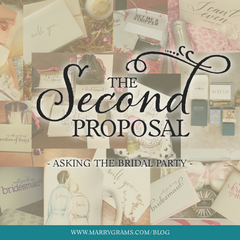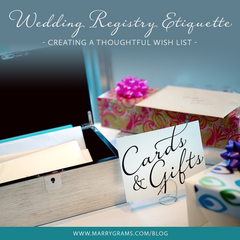Wedding Invitation Etiquette 101 - Everything You Need To Know
Finding or designing a wedding invitation suite you love is the easy part. Figuring out what needs to go on it? That's a bit trickier. Your wedding invitations set the tone for your event as well as convey all of the important details your guests need to know. So it's important that you follow some etiquette guidelines to make sure there is no confusion. From how to include your parents to how much postage you'll need - our guide will help you answer all of your biggest wedding invitation questions.
When do we send them out?
Traditionally you will send your invitations six to eight weeks before the wedding. This gives your guests plenty of time to make any necessary travel or work arrangements. It is also not too far in advance that people put your invite in a drawer and forget about it. However, if you're having a destination wedding that requires a bit more preparation it is recommended that you send your invites out two to three months before the wedding.
How long do people have to RSVP?
Have your RSVP deadline two to three weeks before your wedding. This is when you will need to give your caterer final head counts and finalize your seating charts. Ideally, most of your guests will RSVP before then, but be prepared to make a few phone calls to the stragglers. Some brides even have a double RSVP system. One in the wedding invitation and another option to respond via the wedding website as a backup. Do whatever works best for you and your guests, but ALWAYS make sure you include a paper option with the main invitation.
What essential information needs to be on them?
Good question! Your wedding invitation can be as sparse or dense as you need it to be. But they should at the very least include the names of the bride and groom, the venue address, date and time of ceremony and reception location. Additional details like travel accommodations, local attractions, dress code, etc. can be included on insert cards or on the wedding website.
How many inserts do we actually need?
Depends! If you're planning a bunch of fun activities outside of the wedding itself - an additional insert with local attractions, events, and hotel information is a big help. Many brides include maps of the venue, hashtag cards and travel info here too. If you're not into the idea of creating a wedding website for all of the extra need to knows, then inserts are the way to go. But as long as your guests can get all of the information they need somewhere, it's totally up to you how full you stuff that envelope.
We're paying for our own wedding - Do we include our parents on the invite?
Again, it depends. Usually on who is hosting, and how formal or informal your ceremony is. Traditionally the bride's parents are listed first on the invitation, for example:
Mr. and Mrs. John Doe
request the pleasure of your company
at the marriage of their daughter
Jane Marie
to
John Jacob Douglas
However, with more couples footing their own bill this is becoming less common. If you are close to your parents and want to honor them on your invitation, by all means, do so! But as casual ceremonies continue to gain popularity, the etiquette is fuzzy at best. Talk to your parents about how they would like to be included and come up with a solution that works best for you. The internet is full of fun ways to include your folks on your invites in a less formal, but still meaningful, way.
Can we include registry information?
In a word, no. It's considered poor taste to include your registry information on your wedding invitations (as it looks like you're more interested in trolling for flatware than inviting guests to a wedding). Rely on your bridal party and family members to let your guests know where you are registered. And if you must include it somewhere, your wedding website is a perfectly fine platform.
How do we specify an "adults only" event?
Properly addressing your invitations is key. If you are having an adults only wedding be sure to address your invites to the specific individuals you want to attend. For example - Mr. John Doe and Family implies that children are allowed, Mr. John and Jane Doe does not. You can also word your RSVP cards to say something like, "We have reserved 2 seats in your honor." That way there is no confusion about who is invited.
Be prepared for some of your guests to ignore this request. You may have to make a few phone calls to let people know that you are having an adults only event and you hope they are still able to make it. Another (entirely optional) idea if you have a lot of friends and family with little ones, is to hire an on site babysitter for the evening to keep the kiddos entertained.
What if we have a wedding website?
That's great! The wedding website is quickly becoming a wedding planning staple, and for good reason. It's an easy place to keep all of your important wedding information readily accessible. Use it to post pictures, any updates or changes, and additional event information that isn't included in the initial invitations.
How do we convey the dress code?
You invitation design and style will help convey the tone of the event, and thus, the dress code. It is common to include the dress code (black tie, casual attire, etc) on the bottom right hand corner of the invitation. But if you don't want it on your main invites you can always make a note of the dress code on your wedding website.
How do we let guests know if they have a plus one?
Again, it's all in how you address the envelopes. For example: Mr. John Doe & Guest or Mr. John Doe and Susan Deer. A good rule of thumb is to give a plus one to your bridal party and any guests who are in a committed relationship of a year or more. But remember, it's your wedding. And you do not have to invite anybody you do not want to.
Where does the return address go?
Traditionally your return address goes on the back flap of the wedding invitation.
How much postage do we need?
It varies by size, shape and amount of inserts. So we always recommend taking a fully stuffed invitation to the post office to weigh before purchasing postage. And don't forget to include stamps on your RSVP envelopes! You want your guests to be able to check a box and stick those right back in the mail, without having to hunt for a stamp.









